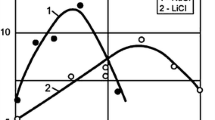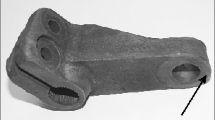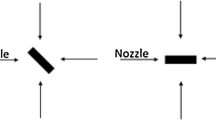Abstract
Immersion cooling, refers to direct cooling (usually by a liquid quench) of the metal from its heat austenitizing temperature to, or at least to near, ambient temperature. This is the most commonly used method in the quenching of quench-hardenable steels. It is also used for rapid cooling of metals that have been solution treated at elevated temperature.
Access this chapter
Tax calculation will be finalised at checkout
Purchases are for personal use only
Preview
Unable to display preview. Download preview PDF.
Similar content being viewed by others
References
Didier G, Archambault P, Chevrier JC, Moreaux F (1981) Utilisation d’un miniordinateur pour le pilotage en temps réel de refroidissements par pulvérisation. Mémoires Scientifiques, Revue de Métallurgie, June, pp 293-302.
Bieth M, Moreaux F, Beck G (1976) Caractéristiques du transfert thermique entre un solide à haute température et un jet diphasique. Entropie, 71, pp 42–49.
Didier G, Archambault P, Moreaux F (1983) Automatisation d’un système de refroidissement par pulvérisation pneumatique. Revue Générale de Thermique, 256, April, pp 333-339.
Denis S, Basso C, Fernandes FMB, Simon A (1986) Contribution des contraintes internes d’origine thermique dans le calcul de l’avancement des transformations de phase en refroidissement continu d’un acier XC80. Mémoires Scientifiques, Revue de Métallurgie, October, pp 533-342.
Archambault P, Chevrier JC, Beck G, Bouvaist J (1980) Contribution to the optimisation of the 7075 heat treatment. Materials Science and Engineering, 43, pp 1–6.
El Fenne M, Archambault P, Moreaux F, Pourprix Y (1987) Trempe par pulvérisation d’eau après chauffage superficiel par induction. Cas d’un acier XC42. Traitement Thermique, 207, pp 31–34.
Pierronnet M, Archambault P, Moreaux F, Clement B, Beauget M (1988) Comportement métallurgique et mécanique d’aciers trempés par induction après cémentation. Traitement Thermique, 222, pp 35–41.
Kobasko NI, Prokhorenko NI (1964) Cooling rate effect of quenching on crack formation in 45 steel—Metallovedenie i termicheskaya obrabotka metallov (MiTOM). No. 2, pp. 53-54.
Kobasko NI (1970) Crack formation at steel—quenching MiTOM. No. 11, pp. 5-6.
Bogatyrev JuM Shepelyakovsky KZ Shklyarov IN (1967) Cooling rate effect on crack formation at steel quenching—MiTOM. No. 4, pp. 15-22.
Kobasko NI, Morganyuk VS (1981) Study of thermal and stressed states of machine-building parts in the process of heat treatment. Kiev: Znanije Ukr. SSR, pp. 16.
Kobasko NI, Morganyuk VS (1983) Study of thermal and stressed-strained state at heat treatment of power plant industry parts.-Kiev: Znanije Ukr. SSR, pp. 16.
Ganiev RF, Kobasko NI, Frolov KV (1987) On principally new ways of increasing metal part service life—Doklady Academii Nauk (DAN) USSR. Vol. 194, No. 6, pp. 1364–1473.
Kobasko NI (1986) Increase of service life of machine parts and tools by means of cooling intensification at quenching—MiTOM. No. 10, pp. 47-52.
Kobasko NI, Nikolin BI, Drachinskaya AG (1987) Increase of service life of machine parts and tools by creating high compression stresses in them—Izvestija VUZov (Machinostrojenie). No. 10, pp. 157-157.
Kobasko NI (1989) Increase of steel part service life and reliability by using new methods of quenching—Metallovedenie i termicheskaya obrabotka metallov. No. 9, pp. 7-14.
Kobasko NI, Morganyuk VS (1985) Numerical study of phase changes, current and residual stresses at quenching parts of complex configuration—4th Int. Congr. Heat Treatment Mater. Berlin. June, pp. 466-486.
Kobasko NI (1988) On the possibility of controlling residual stresses by changing the cooling properties of quench media—Metody povyshenija konstruktivnoi prochnosti metallicheskikh materialov.-M.: Znanije RSFSR, pp. 79-85.
Ovaku Sigeo (1987) Intensive cooling—Kinzoku Metals & Technol. Vol. 57, No. 3, pp. 48–49.
Lykov AV (967) Theory of Heat Conduction.-M.: Vysshaya Shkola, p. 560.
Kobasko NI (1988) Method of part quenching made of high-alloyed Steels—Inventor’s certificate 1215361 (USSR).—Bulletin of inventions. No. 12. Applied 13.04.1983. No. 3579858 (02-22).
Naito Takeshi. Method of steel quenching. Application 61-48514 (Japan), 16.08.1984, No. 59-170039.
Kobasko NI (1968) Thermal processes at quenching—MiTOM.-No. 3. pp. 2-6.
Kobasko NI (1988) Method of steel quenching—Inventor’s certificate No. 797243 (USSR).—Bulletin of inventions No. 7, Applied 13.02.1978, No. 2578660 (02-22), C 21 1/56.
Lyman John R. High carbon steel microcrecking control during hardening—Pat. 4523965 (US). 07.03.1983. 472656.
Morganyuk VS, Kobasko NI, Kharchenko VK (1982) On the possibility of predicting quench cracks—Problemy prochnosti. No. 9, pp. 63-68.
Troshchenko VT (1980) Metal strength under variable loads.-Kiev: Naukova Dumka, pp. 206.
Kobasko NI (1980) Steel quenching in liquid media under pressure.-Kiev: Naukova Dumka, pp. 206.
Kobasko NI (1967) Effect of structural and thermal stresses on crack formation at steel quenching—In book: All-Union conference on increasing output and economical efficiency of heating furnaces. Dnepropetrovsk. December 1967: Abstracts of papers, Dnepropetrovsk, pp. 26-27.
Ganiev RF, Kobasko NI, Kulik VV et al. (1980) Vibration phenomena in multiphase media and their application in technology. Kiev: Tekhnika, p. 144.
Ganiev RF, Dolinsky AA, Kobasko NI, Frolov KV (1987) Phenomenon of anomalous mechanism of heat and mass transfer processes in multiphase media. —Diklady Academii Nauk SSSR, Vol. 294, No. 3, pp. 560–563.
Nakajama Khisakhoko, Tsunatsu Eidzi, Sakamoto Massaki, Akasi Tsunema (1985) Deep-free treatment in liquified nitrogen—Tumandzo to netsu syori: Cast. Forg. and Heat Treat. Vol. 38, No. 10, p. 25.
Correspondence readers’ conference at Likhachev plant—MiTOM. 1965, No. 6, p. 72.
Natanzon El, Rwmyankd LS (1976) Simultaneous quenching of truck semi-axes—Avtomobilnaya promyshlennost. No. 10, pp. 33-35.
Kobasko NI, Lisovoy VA, Khalatov AA (1988) Method of controlling quenching process—Inventor’s certificate (USSR). —Bulletin of inventions No. 18. Applied 10.11.1986, No. 4145886 (31-02).
Tensi HM, Kiinzel Th, Stitzelbergen F (1987) Benetzungskinetik als wichtige Kenngrösse für die Härtung beim Tauchkühlen—Härt. Techn. Mitt.-Bd. 42. Nr.3.-S. 125–131.
Archambault P, Didier G, Moreaux F, Beck G. (1984) Computer controlled spray quenching—Metal Progr. Vol. 126, No. 5, pp. 67–72.
Liscic B, Filetin T (1987) Computer-aided determination of the process parameters for hardening and tempering structural steels—Heat Treat. Metals. Vol. 14, No. 3, pp. 62–66.
Liscic B, Filetin T (1985) Mikrokomputer-gestütztes Sonde-Ekalon-Verfahren zur Messung der realen Abschreckintensität und zur Vorausbestimmung der Härteverteilung am Rundquerschnitt beim Härten—Int. Congr. Heat Treatment Mater. Berlin. June, S. 1266-1285.
Kern Roy F (1986) Intense quenching—Heat Treating. No. 9, pp. 19-23.
Editor information
Editors and Affiliations
Rights and permissions
Copyright information
© 1992 Springer Science+Business Media New York
About this chapter
Cite this chapter
Boyer, H.E., Archambault, P., Moreaux, F., Kobasko, N.I. (1992). Techniques of Quenching. In: Liščić, B., Tensi, H.M., Luty, W. (eds) Theory and Technology of Quenching. Springer, Berlin, Heidelberg. https://doi.org/10.1007/978-3-662-01596-4_10
Download citation
DOI: https://doi.org/10.1007/978-3-662-01596-4_10
Publisher Name: Springer, Berlin, Heidelberg
Print ISBN: 978-3-662-01598-8
Online ISBN: 978-3-662-01596-4
eBook Packages: Springer Book Archive




